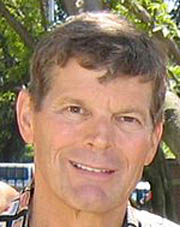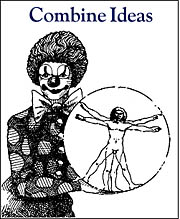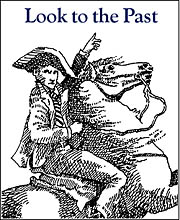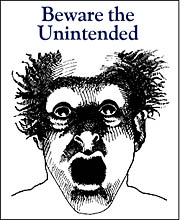Releasing our Mental Blocks
An Interview with Roger Von Oech, author of A Whack on the Side of the Head We become locked in our old ways of thinking, and we often assume our past and current successes are the path to future success. But inevitably every current success will become a future failure if we keep thinking and doing things in the same manner.Don't become trapped by thinking "I'm not creative". The creative process is hard work but it can also be a lot of fun.
 We need to be aware that we have "mental locks", which Roger von Oech describes in A Whack on the Side of the Head as being especially hazardous to our thinking. These mental locks are:
We need to be aware that we have "mental locks", which Roger von Oech describes in A Whack on the Side of the Head as being especially hazardous to our thinking. These mental locks are:- The Right Answer
- That's Not Logical
- Follow the Rules
- Be Practical
- Play is Frivolous
- That's Not My Area
- Don't Be Foolish
- Avoid Ambiguity
- To Err Is Wrong
- I'm Not Creative
A Whack on the Side of the Head was first published in 1983 with revised and enhanced editions published in 1990 and in 1998. Today the fourth edition of this book is being released—on the 25th anniversary of the first edition!
VB: Congratulations on your 25th anniversary and on the release of the fourth edition.
 Roger von Oech: Thank you. I think creativity is a really fun and upbeat subject. It's also an important one. When I commenced on this project twenty-six years ago, I wanted to create a book that was fun, interactive, accessible, and had a lot of interesting anecdotes and stories. Above all I wanted it to contain some basic strategies, some principles people could use. And I hoped it would be perennial.
Roger von Oech: Thank you. I think creativity is a really fun and upbeat subject. It's also an important one. When I commenced on this project twenty-six years ago, I wanted to create a book that was fun, interactive, accessible, and had a lot of interesting anecdotes and stories. Above all I wanted it to contain some basic strategies, some principles people could use. And I hoped it would be perennial.The 25th anniversary edition is the fourth edition I've done but the first in ten years. I'm really excited about it. A whole new generation of creative thinkers has come along and I hope they discover A Whack on the Side of the Head can enhance their creative thinking abilities.
VB: What has made your book a consistently strong seller?
Roger von Oech: It’s not filled with a lot of jargon and technical stuff. Plus I've updated it over the years.
Before A Whack on the Side of the Head, it seemed most creativity books were pretty dry. There weren't a lot of pictures, not very many exercises. I wanted to have a fun book that was accessible, that had odd stuff in it, stories, and true facts that provoked the reader. And a book that was fun but had some practicality so readers could relate it to their life or their business. I guess enough people responded to that approach to make it a go.
Plus my timing was good. It was one of the first books that kick started the whole creativity in business movement which started in the late 1970s and early 1980s.
VB: Who is your book written for?
Roger von Oech: At least half of my mail over the years has come from business people but when you read A Whack on the Side of the Head it's pretty all purpose. I receive mail from all walks of life: teachers, entrepreneurs, housewives, coaches, a lot from ministers, students, athletes, and people in prison—to name a few.
VB: You include numerous examples and stories from history.
Roger von Oech: I think the stories and examples I use is another reason the book has done well over the years. If I have a choice between giving an example that has happened in 2006 or 2007, on the one hand, or something that happened in 1850 or 1550 or 200 BC I will go with the ancient example. It holds up better over time. You read examples from three or four years ago and think they seem rather passé now but there is something perennial about stories from two or ten centuries ago. The message is human beings have been grappling with these types of problems for a long time and even they got locked into their ways of thinking and finding out things.
For example, Ronald Reagan was in his first term as President of the USA when the first edition of the book was published, but there are no examples of Reagan included. It would have made the book more topical when it was published but it would seem really dated now. While the stories about the Athenians and Spartans fighting off the Persians have a timeless quality to them.
VB: What initially gave you the idea to write a book on creativity?
Roger von Oech: I used to produce innovation conferences; they were called "Innovation in Industry". At the first one I did in 1981 Steve Jobs, who was then just twenty six years old, was a speaker. I asked him "why did you start Apple". He said "well, we make what we want for ourselves." He went on to say he wanted a personal computer but there wasn't one available to him so he had to put himself in the position of learning about marketing, engineering, getting to be friends with Steve Wozniak to create the Apple company.
I've observed that making what you want for yourself is one of the hallmarks of being an entrepreneur or of making something happen. It's not the only factor but it's an important factor. That certainly was the case with my book.
VB: What are some of the highlights of the changes you've made in the 4th edition?
 Roger von Oech: I guess the question may be why change a classic book. I've always considered A Whack on the Side of the Head to be a living book, one I could update and revise over time. Since the third edition I've had a number of insights, thoughts, and stories I wanted to include.
Roger von Oech: I guess the question may be why change a classic book. I've always considered A Whack on the Side of the Head to be a living book, one I could update and revise over time. Since the third edition I've had a number of insights, thoughts, and stories I wanted to include. When I was younger I thought anything goes, it was wide open. That's still not a bad attitude to have at the front of the creative process but I now have a much better appreciation for the role of constraints and limitations in stimulating creativity. So there are a couple of new sections on the value of constraints.
I incorporated a lot more of Heraclitus into this edition. I consider him to be the world's first creativity teacher.
I also developed the humor a bit more. If one laughs at a problem, a product or a way of doing business it frees the mind from a lot of deeply imbedded assumptions. I've included some of my favorite tales from my workshop and seminar experiences. As an example, I asked a group of vice presidents in one of my seminars to make up an offbeat motto for Bank of America. The motto they created was: "Bank of America, where you're not alone until you want a loan." For IBM the motto was: "IBM where creative people meet and meet and meet and meet." For Microsoft the motto was: "Microsoft we're arrogant and we should be." Or AT&T: "Call us up and we'll give you a line." Pacific Gas & Electric: "We've got our customers by the bulbs."
The 4th edition has more pages but is smaller in size.
VB: What is the key message, or messages, in the book?
Roger von Oech: The backbone, the framework of the book, is the ten mental locks that prevent people from being more creative. They make sense for ninety five percent of what you do. But when you're trying to be creative they get in the way. People can intuitively understand these mental locks.
The best way to be creative in terms of dealing with mental locks, such as "I'm not creative" is to temporarily unlearn them. To become a little impractical, to play around, to look for ideas in other areas. Often the mental locks are so drilled into our thinking we're not aware they're there. What we need then is a good jolt to our mental apparatus and that's my metaphor "a whack on the side of the head". It forces us out of our routine way of thinking and enables us to start looking in other places.
VB: Attitude seems to play an important part in enabling one to be creative or inventive. Thinking "I am not creative" is a self-fulfilling prophecy. Would you talk about the importance of attitude?
Roger von Oech: Attitude is everything. This is true whether you’re a high jumper attempting to clear the bar, or a salesman hoping to close a sale.
The same thing is true with creativity. Creativity can be a really messy thing. You're dealing with paradox, ambiguity, and the rules don't quite apply. There are weird contexts. Not everything is right or wrong. So it can be confusing.
If you don’t think you're creative, you won't even try to start churning your creative processes. But if you think you are, you will get in there and take a whack at it. You'll try a few things. It's attitude that determines whether you will put yourself in a position to engage in the creative process.
VB: You talk about the value of trusting our unconscious mind. How can we cultivate our ability to hear, trust and follow what our unconscious mind is telling us—especially given many people's propensity for self-doubt and need for scientific proof?
 Roger von Oech: I will tell you about my experience. The way I typically work best is to learn as much as I can about a problem or project, or whatever else I'm dealing with, and then back away from it for a day or a couple of days. Then good ideas just seem to come to the surface.
Roger von Oech: I will tell you about my experience. The way I typically work best is to learn as much as I can about a problem or project, or whatever else I'm dealing with, and then back away from it for a day or a couple of days. Then good ideas just seem to come to the surface. Sometimes before I go to bed I visualize the problem I'm working on and the next morning I'll have a different approach on things.
There's so much about the mind and the brain that we don't know—whether it's a fragment of a dream or the brain repairing itself in new ways. But there's nothing like getting away from a problem for a few days after you've put a lot of hard work into it and letting the unconscious part of your brain work its wonders.
VB: When many think of creativity they usually think of the famous and successful.
Roger von Oech: Yes, there's a danger when you think of creativity you will think of Beethoven, Einstein, Picasso, or entrepreneurs like Steve Jobs or Richard Branson. Too often they believe that they’re the superstars and they can never be like them.
Most of the time the great minds don't get big ideas "out of the blue." Usually they get big ideas by paying attention to, manipulating and playing with medium-sized ideas. Some of these ideas turn into bigger things. The same is true of medium ideas. Most were once small ideas.
The key difference between creative people and people who are less creative or don't even get involved in the creative process, is creative people tend to pay attention to their small ideas, give them some value and see where they lead. Ninety percent might not lead anywhere. But some do. That's been my experience with my own products. And also the experience of a lot of creative people I've been around.
You don't need to be creative for most of what you do. It may only be appropriate for ten or fifteen percent of what you do during the day—in product design, running a household or whatever else you're doing. Most of the time you have to do things by the rules or in a straight forward manner.
But when there is a need to be creative it's important to be able to say "I'm going to challenge this rule", "I'm going to drop this assumption", "I'm going to look at it backwards", or "I'm going to look at things upside down". And I ask myself what can I learn from this, where does it lead?
VB: One of Heraclitus' thirty creative epigrams is "Every walking animal is driven to its purpose with a whack". Is it the original inspiration for your metaphor of a whack on the side of the head to describe what is needed to shake us out of routine patterns, to force us to re-think our problems, and to stimulate us to ask the questions that may lead to other right answers?
Roger von Oech: It actually came from modifying a couple of old Zen stories, which resulted in the message that we need the ability to unlearn what we know.
One is about a student who goes to his teacher for afternoon tea and after chatting for awhile the teacher starts pouring tea into the student's cup. He pours until the tea overflows the cup; it overflows the saucer and flows onto the floor. And yet the teacher keeps pouring. The student says "you've got to stop pouring because the tea is overflowing". The teacher answers that is exactly right, if you are to receive any of my teaching you have to empty out your mental cup too because you've already got assumptions that prevent you from learning anything.
In the second story the student goes back for another lesson. The teacher tries to explain a point and the student just doesn't get it. The teacher picks up a stick and gives him a “whack on the side of the head,” and the student finally does get it.
That's where it came from. It's fortunate that the Heraclitus epigram you quoted applies here as well. I think in Greek it says something like every four legged animal is driven to its purpose with a “blow,” and in my translation I made it conform to my own terminology.
VB: These whacks can come in many different forms.
Roger von Oech: Some whacks can be fun. Other times they can be painful like loosing a job, failing or trying an approach that doesn't work. The whacks force you to try something else.
One of the key things that prevents people from being more creative is they become prisoners of familiarity. What I mean is the more often you do something in the same way again and again and again the more difficult it becomes to do it in any other way. You get locked in. Sometimes you need a jolt to your mental apparatus, the whack on the side of the head to get you out of that pattern of thinking.
VB: You say metaphors are one of your passions. Why?
Roger von Oech: Yes, I like them, I think most people do. They are one of the most powerful tools a creative thinker has at his or her disposal. I typically think in pictures and metaphors are basically word pictures.
If somebody explains a problem to me by using a juicy metaphor I find it helpful. Most good teachers use metaphors. Legendary teachers such as Jesus, Plato, and Buddha used metaphors to get their complex ideas across. I think the mind responds well to them.
VB: It helps people visualize what you're trying to communicate.
Roger von Oech: Absolutely. They're memorable too. What kind of speaker would you rather hear, someone who just gives you a lot of text and words, or someone who gives you some metaphors, especially new fresh metaphors?
VB: The speaker with metaphors! Tell me about your model of the creative process.
Roger von Oech: People who are successful creative thinkers adopt four different kinds of thinking as they generate, manage and apply ideas.
Early on they think like explorers. They're open, probing, and curious. They look for ideas in a lot of places.
Then they think like artists. They take the information they've found and ask "what if", "why not", and "how can I solve the problem or turn it into something new". Then the mind shifts to a whole different way of thinking.
They become judges. They say "does this idea solve my problem"; "do we have the resources for it", "is the timing right", "is this the right way to go". The judge is the one who finally says "yes, proceed to implement it".
Because most of the world has its defenses up to keep out new ideas, at this point they become what I call warriors. Their thinking at this stage is to figure out how to meet their objective. They put their strategy together, motivate themselves and their team, sell, get rid of excuses, and hopefully make their idea a reality.
VB: You say we should not be satisfied with the first right answer, and the best way to get a good idea is to get a lot of ideas. Would you describe your concept of the second right answer?
Roger von Oech: If I have a mantra or a motto that has served me well over the years it is look for the second right answer. I think for a lot of people as they go through school, especially the more technical studies and curricula, there's a tendency to learn the kind of thinking where you look for the one right answer. That's fine for certain kinds of problems but I think most of life has a variety of right answers. Such as how you write a blog, how you get to work, how you're going to design something or how you're going to write this article for IdeaConnection.
If your attitude and approach is to you stop at the first right answer what that typically means is you have an approach that worked for you last year, or two years ago or five years ago. Now you have a similar problem and you just apply the same approach to it. You have come up with the first right answer.
VB: How can we tell which are the right right answers?
 Roger von Oech: That's less a concern for the explorer early on in the creative process than it is for the judge who has to sort these things out. It's a lot easier if in the explorer stage you go beyond the first right answer. The chances are if you've got five or eight right answers one of them is going to be more creative than the first right answer that worked for you a year or two ago.
Roger von Oech: That's less a concern for the explorer early on in the creative process than it is for the judge who has to sort these things out. It's a lot easier if in the explorer stage you go beyond the first right answer. The chances are if you've got five or eight right answers one of them is going to be more creative than the first right answer that worked for you a year or two ago. It is a mental discipline to go beyond past successes and find the offbeat, strange, or humorous answer, the one that worked two hundred years ago, the one that worked one thousand years ago, or the one that might work one hundred years from now with different technology. It's that kind of approach.
VB: You say that by focusing students from kindergarten through post secondary education on "the right answer" we cause youth to loose much of their innovative power. You also say that almost every advance in art, medicine, agriculture, engineering, marketing, politics, education and design has occurred when someone challenged the rules and tried another approach. Do you think the educational system also places too much emphasis on instilling rules and patterns of thought? What changes do you think could be made in the educational system in order to enhance creative thinking abilities in future generations?
Roger von Oech: It's important to master the basics. I don't agree with those who say "let it all go". If you are going to do innovative chemistry work you've got to know the basics about how molecules come together, and so on. Or if you're going to be an innovative mathematician you have to have the basics as well.
But in the course of all this learning I think it's important to stress there are second right answers. There are alternatives. Anybody who has any sense of the history of any field, such as mathematics, chemistry, or literature, will realize that people have had different approaches over the years.
The term we used to hear a lot is paradigms. I'm not a person who uses that term a lot but this would be a good place to use it. For example, certain ideas hold sway and then different ones come forward.
I think we should teach there are other right answers in any particular field. It's important to be able to play with a problem. To be able to question your assumptions. And to realize every right idea is eventually the wrong idea.
For eighty percent of what you're doing you've got to master the basics. But for twenty percent you need to question methods and look for other interpretations and impressions.
It's been my experience that the more creative people are the ones who had different kinds of odd jobs while going through school. They mowed lawns, traveled, read fiction, or tried other things—compared to students who just learned SAT words, didn't have a balance of activities and who don't seem very happy either.
VB: You say failure is often an important stimulus for being more creative, generating new ideas or moving toward more rewarding endeavors. Are failures or significant setbacks therefore to be welcomed?
Roger von Oech: I don't think anyone likes failure. My typical reaction when failure happens even in a small way is I realize I was locked into one approach and it didn't work out. That frees me up to try something else. The sooner I can get to that place the more helpful it is for the creative process.
VB: You talk about the value of play, having fun, and a humorous frame of mind in stimulating creative thinking. I assume you have a very good sense of humor.
Roger von Oech: I love jokes, off-beat humor and strange things. Sometimes I'll find things funny that others don't. Often it's a playful way of looking at the world.
A quote that used to be prevalent was "for those who feel the world is a tragedy, for those who think the world is a comedy". I'm probably more of a thinker than a feeler.
VB: And there are benefits of having a good sense of humor and playfulness.
Roger von Oech: Playfulness is key. And sometimes humor results from it as well. When you're playing in your mind you're manipulating concepts, you're moving them around.
That's the kind of thing you like to see in the creative process. Asking "what if" is a kind of play.
VB: Do you have any favorite books on creativity?
Roger von Oech: I think Conceptual Blockbusting by James Adams is a really good book. I guess my all time favorite creative thinking book is The Act of Creation by Arthur Kessler. It was first published in about 1962, and comes from a much different tradition than my book.
Conclusion:
We have the potential to be creative as long as we don't think we're not creative. And creativity is a process, it's not just magic.
Roger von Oech describes the creative process as entailing two main phases. In the imaginative phase new ideas are generated. The motto is "thinking something different", and a whack on the side of the head can be very useful. In the practical phase these new ideas are evaluated and implemented.
 The fourth edition of A Whack on the Side of the Head should soon be available from local bookstores—or it can be ordered through these retail outlets. Also it is now available from Amazon.com. It should be available from Amazon.ca soon and from Amazon.uk in June.
The fourth edition of A Whack on the Side of the Head should soon be available from local bookstores—or it can be ordered through these retail outlets. Also it is now available from Amazon.com. It should be available from Amazon.ca soon and from Amazon.uk in June.Roger von Oech has a graduate degree from Ohio State University and a PH.D. from Stanford University. He founded Creative Think in 1977 and since then has provided seminars, consulting services and creativity products.
